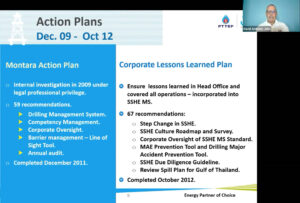More than a decade on, impacts from Montara blowout still felt at PTTEP
By Stephen Whitfield, Associate Editor

Although it has been nearly 12 years since the Montara blowout became one of the worst disasters in Australian history, operator PTTEP says it continues to improve and evolve its safety culture based on lessons learned from that incident. Speaking at the 2021 IADC Drilling HSE&T Asia Pacific Conference on 18 May, David John, Specialist in Process Safety at PTTEP, discussed the changes and impact that blowout continues to have on PTTEP’s safety culture.
The Montara H1 ST1 well in the Timor Sea, offshore Western Australia, blew out on 21 August 2009. While there were no fatalities or injuries, the spillover from the blowout was severe. Over a three-month period, PTTEP lost approximately 400 bbl/day, although no oil reached a shoreline. The spill response, which was coordinated by the Australian Maritime Safety Agency (AMSA), lasted from 21 August to 3 December and involved 320 people, 12 aircraft and 17 vessels. Approximately 140 million cu m of dispersant were sprayed and 4,000 bbls of oil were skimmed from the Timor Sea during the cleanup effort.
In its investigation, the Australian government determined the main causes of the blowout to be failure to maintain verified well barriers, a lack of personnel competence, failure to follow procedures, and limited corporate oversight. Based on these findings and findings from its own internal investigation, PTTEP immediately began taking steps for improvement.
“We had to improve safety management throughout the company,” Mr John said. “We looked at numerous safety surveys, developed a safety culture roadmap, and we put in corporate oversight of safety standards so that we could better understand what we were doing and what the risks are, as well as making sure that those risks are being controlled at the asset level.”
Among the initiatives PTTEP undertook was developing the Major Accident Event (MAE) prevention tool. It is an electronic monitoring platform with built-in indicators for lost-time injury frequency, total recordable injury rate, oil and chemical spill rate and loss of primary containment. The tool can forecast future performance in these metrics and send alerts if performance deviates from the company’s target.
The company also developed an e-Management of Change (e-MOC) system to help improve process safety. It also organized “My Barrier” programs for training personnel on managing specific process safety hazards and barriers. These programs include an engineering and construction project assurance program that ensures the identification of MAEs from a design perspective and self-imposed operational safety cases for each operating asset.
Further, the company reconfigured its drilling management systems to account for lessons learned from Montara. One of the most significant changes made was PTTEP now requires a minimum of two verified barriers in place during drilling and well operations.
Another tool PTTEP developed was called Line of Sight. Among other things, the tool was designed to provide assurance of process safety management by demonstrating that frontline operational activities are being conducted in accordance with company policies, procedures and rules. It helps PTTEP to identify essential barriers or controls to MAEs and to carry out checks on the health of each barrier. The status of each barriers is recorded and reported into the system and made available to all levels of management.
While MAE, Line of Sight and e-MOC are all indicative of PTTEP’s commitment improve safety, Mr John noted that organizations must not become complacent. PTTEP has seen a decline in its total recordable injury rate recently, which dropped from 0.75 cases per million hours worked in 2018 to 0.32 in 2020. Its oil and chemical spill rate also dropped from 0.60 tonnes per million tonnes of production in 2018 to 0.08 in 2020. However, lost-time injury frequency and loss of primary containment rates have seen some slight increases in the same time period, according to Mr John.
He pointed out that, in the wake of the Montara blowout, the Australian government passed the Work Health and Safety Act 2011, which required businesses to take all reasonable action to prevent and prepare for oil spills. This includes ensuring that appropriate equipment and training has been provided. A 2013 amendment to the Offshore Petroleum and Greenhouse Gas Storage Act 2006 authorized the National Offshore Petroleum Safety and Environmental Management Authority (NOPSEMA) to direct title holders to take specific actions in response to incidents in state waters.
The amendment also requires the title holder – instead of the AMSA – to clean up and monitor the impact of an oil spill in state waters. If a title holder fails to fulfill their obligations in managing an incident, NOPSEMA will carry out those actions, but the title holder would remain financially liable for the costs associated with incident response.
“Our challenge as an industry is to ask whether we’ve taken all of these causes in quickly enough to where we can fully understand the lessons learned behind these incidents,” Mr John said. “Do we need to reevaluate these lessons on a periodic basis to make sure we’re really learning what we need to learn as we go along?”




